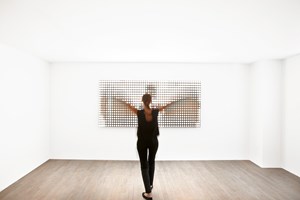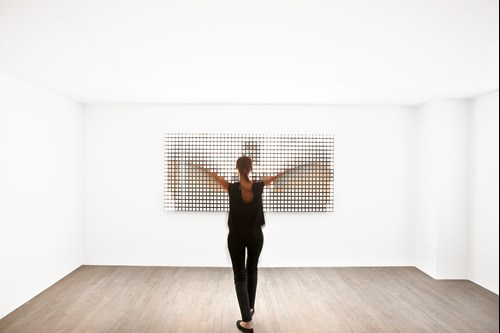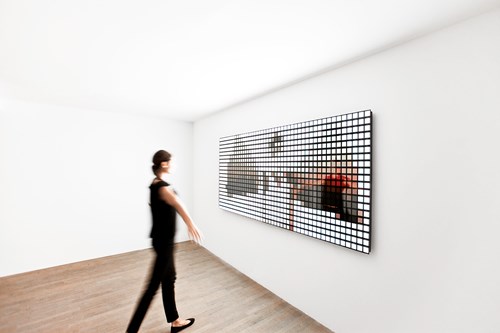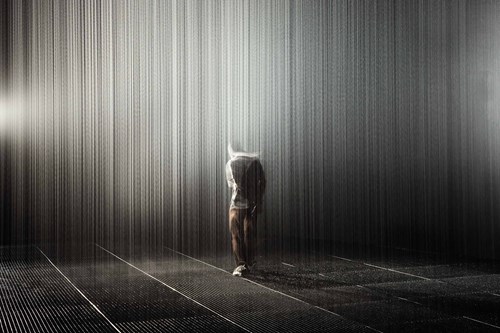
RANDOM INTERNATIONAL was founded in 2005 by Hannes Koch and Florian Ortkrass. They invite their public to engage and participate with highly technological and experimental artworks. The studio today consists of a wider team of more than 20 based in London and Berlin.
RANDOM INTERNATIONAL was founded in 2005 by Hannes Koch and Florian Ortkrass. They invite their public to engage and participate with highly technological and experimental artworks. The studio today consists of a wider team of more than 20 based in London and Berlin.
PG: Where do you find your inspiration?
From conversation, predominantly. Initially between the two of us and then with others; in the process of developing work in the studio, there’s a lot of things to be discovered. We really celebrate experimentation and thrive on things that we haven’t tried before. Not necessarily easy but definitely inspiring.
PG: Rain Room is maybe your most successful work. Were there any pitfalls during the creation? How did you get out of it? What have you learned?
We just dreamt it up and there it was...ahem, not. Where to begin? The idea took 30 seconds to come up with and then the subsequent process of realisation took the better part of 4 years, prior to its first being shown at Barbican. One pitfall was that we just didn’t know how start it, and we only overcame when we eventually did start it. The trust of the Frankel Foundation for Art helped a lot here. We learned that the state of not-knowing is really valuable, and worth remaining in for a while...it helps to develop the vision. Another pitfall was our first aesthetic approach, didn’t at all account for the invisibility of falling water drops, when not properly lit. We solved that through through making the space very dark and then lightning in a particular, dramatic way.
PG: Main theme in your work seems to be the interaction with the viewer/visitor. How do you see social engagement in (contemporary) art? Do you deem it necessary? Or supplementary?
Very necessary, at least for our work. It’s all about the human and their experience from her/his perspective. Of course the engagement starts with ourselves, without which we wouldn’t proceed to presenting work publicly, but once we decide to make a work, it really belongs in the most public context possible. For us it’s a means of connecting with the world around us and trying to understand it better, and differently. And of course to communicate through it — at the moment particularly on people’s current engagement with machines on a daily (or minutely) basis.

RANDOM INTERNATIONAL, You Fade to Light, 2009. Photo Courtesy RANDOM INTERNATIONAL

RANDOM INTERNATIONAL, You Fade to Light, 2009. Photo Courtesy RANDOM INTERNATIONAL

Rain room. Photo Courtesy RANDOM INTERNATIONAL
PG: The collective is almost a small firm/business. How do you deal with authorship?
We’re not really a collective in the sense that the two of us share the artistic direction of the studio. Of course, we rely to a great extent on engagement with an amazing and insanely talented group of people in our studio. So externally, the primary credit goes to RANDOM INTERNATIONAL, and only the secondary crediting & copyright belongs to Flo & Hannes.
PG: How do you see the further evolution of technology and art?
At the moment, in terms of how people use technology, society seem to be in a similar situation as smokers were in the 1950’s when it was totally ok for the doctor to smoke in his GP’s office while seeing patients. So with technologies evolving faster and faster, we think that art has to take a much more dominant role in contributing to the dialogue that surrounds the decisions that are being made in the fields of AI, robotics and the ethical implications for machine learning, algorithmic autonomy and the social implications for those who are likely being replaced by machines. We can’t leave the discourse to politicians, special interest groups and technologists only, we need to lead these discussions from the front.
PG: What are you currently working on?
On getting in front of those discussions by establishing a more public-facing aspect of RANDOM INTERNATIONAL.
Written by Peter Geerts.

ArtDependence Magazine is an international magazine covering all spheres of contemporary art, as well as modern and classical art.
ArtDependence features the latest art news, highlighting interviews with today’s most influential artists, galleries, curators, collectors, fair directors and individuals at the axis of the arts.
The magazine also covers series of articles and reviews on critical art events, new publications and other foremost happenings in the art world.
If you would like to submit events or editorial content to ArtDependence Magazine, please feel free to reach the magazine via the contact page.